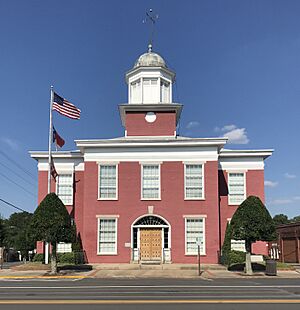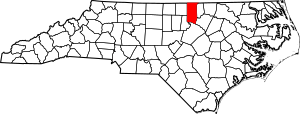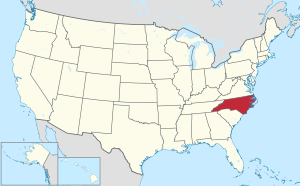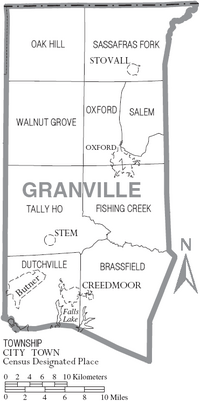Granville County, North Carolina facts for kids
Quick facts for kids
Granville County
|
|||
|---|---|---|---|

Granville County Courthouse
|
|||
|
|||

Location within the U.S. state of North Carolina
|
|||
 North Carolina's location within the U.S. |
|||
| Country | |||
| State | |||
| Established | June 28, 1746 | ||
| Named for | John Carteret, 2nd Earl Granville | ||
| Seat | Oxford | ||
| Largest community | Oxford | ||
| Area | |||
| • Total | 537.59 sq mi (1,392.4 km2) | ||
| • Land | 531.99 sq mi (1,377.8 km2) | ||
| • Water | 5.60 sq mi (14.5 km2) 1.04% | ||
| Population
(2020)
|
|||
| • Total | 60,992 | ||
| • Estimate
(2023)
|
62,192 | ||
| • Density | 114.65/sq mi (44.27/km2) | ||
| Congressional district | 4th | ||
Granville County is a county located in the northern part of North Carolina. In 2020, about 60,992 people lived here. Its main town, or county seat, is Oxford. The county is close to Kerr Lake and Falls Lake. It's also part of the Roanoke, Tar, and Neuse River areas.
Contents
History of Granville County
Granville County was created in 1746 from parts of Edgecombe County. It was named after John Carteret, 2nd Earl Granville. He was one of the original owners, called Lords Proprietors, of the Province of Carolina. He claimed a large part of North Carolina, which became known as the Granville District.
Over the years, parts of Granville County were used to form other counties. In 1752, some of it became part of Orange County. In 1764, the eastern part became Bute County. Later, in 1881, parts of Granville County helped form Vance County.
Important People in Granville's History
John Penn was an important politician from early America. He was one of three people from North Carolina to sign the Declaration of Independence. Penn moved to Granville County in 1774. This area was a center for North Carolina's fight for independence.
John Penn was a great speaker. He joined the Continental Congress in 1776. He also signed the Articles of Confederation for North Carolina. Penn later retired to Granville County and passed away at age 48. His resting place is at the Guilford Courthouse National Military Park in Greensboro.
Early Economy and Changes
Like many early counties in North Carolina, Granville County saw conflicts with Native Americans, such as the Tuscarora uprising. After these conflicts, farmers from Virginia settled in Granville County. They focused on growing tobacco. Early farms in Granville County relied on the labor of enslaved people, which was a common practice in the South at that time. By the start of the Civil War, many enslaved people worked on farms in Granville County.
During the Civil War, over 2,000 men from Granville County joined the Confederacy. One group was called the “Granville Grays.” Many of them fought in major battles and survived the war.
After the Civil War, the economy changed. The use of enslaved labor ended. However, farming continued to do well because of free African Americans in Oxford and a new type of tobacco. Many African Americans in Granville County were free even before the Civil War. They helped build homes and contributed their skills to the area.
The discovery of "bright leaf tobacco" was also very important. This new tobacco crop could be dried in a special way. This made it very popular with farmers and tobacco companies. Granville County remained a top tobacco-producing area for many years. By the late 1800s, Oxford grew into a busy town with new businesses and schools.
Mining and Modern Industry
In the late 1800s and early 1900s, northern Granville County was important for mining. People mined copper, tungsten, silver, and gold. The Richmond to Danville Railroad helped miners and farmers. It allowed them to send their goods to bigger markets in Richmond and Washington, DC.
By the 1950s and 1960s, many factories opened in Granville County. The area slowly moved away from relying only on farming. Today, factories in Granville County make things like cosmetics, tires, and clothing.
Granville County was a major tobacco supplier for the southeastern United States. Many farms had agreements with big tobacco companies. This made local farmers successful. However, during the Great Depression, a new plant sickness called Granville Wilt Disease appeared. It destroyed tobacco crops across northern North Carolina. Scientists at the Tobacco Research Center in Oxford found a way to cure this disease.
Camp Butner
Camp Butner opened in 1942. It was a training camp for soldiers during World War II. Over 40,000 acres in Granville and nearby counties were part of the camp. More than 30,000 soldiers trained there during the war. The hilly land at Camp Butner helped soldiers learn how to deal with gas attacks and use camouflage. German and Italian prisoners also worked at the camp as cooks and janitors. Today, most of the land from Camp Butner belongs to the North Carolina government.
Granville County Courthouse
The Granville County Courthouse was built in 1840. It has a Greek Revival style of architecture. It was added to the National Register of Historic Places in 1979.
Geography of Granville County
Granville County covers about 536 square miles. Most of this area, about 532 square miles, is land. The rest, about 4.9 square miles, is water.
Counties Nearby
Granville County shares borders with these counties:
- Halifax County, Virginia - to the north-northwest
- Mecklenburg County, Virginia - to the north
- Vance County - to the east
- Franklin County - to the southeast
- Wake County - to the south
- Durham County - to the southwest
- Person County - to the west
Main Roads
These are the major highways that go through Granville County:
 I-85
I-85 US 15
US 15 US 158
US 158 NC 49
NC 49 NC 50
NC 50 NC 56
NC 56 NC 96
NC 96
Population Information
| Historical population | |||
|---|---|---|---|
| Census | Pop. | %± | |
| 1790 | 10,982 | — | |
| 1800 | 14,015 | 27.6% | |
| 1810 | 15,576 | 11.1% | |
| 1820 | 18,222 | 17.0% | |
| 1830 | 19,355 | 6.2% | |
| 1840 | 18,817 | −2.8% | |
| 1850 | 21,249 | 12.9% | |
| 1860 | 23,396 | 10.1% | |
| 1870 | 24,831 | 6.1% | |
| 1880 | 31,286 | 26.0% | |
| 1890 | 24,484 | −21.7% | |
| 1900 | 23,263 | −5.0% | |
| 1910 | 25,102 | 7.9% | |
| 1920 | 26,846 | 6.9% | |
| 1930 | 28,723 | 7.0% | |
| 1940 | 29,344 | 2.2% | |
| 1950 | 31,793 | 8.3% | |
| 1960 | 33,110 | 4.1% | |
| 1970 | 32,762 | −1.1% | |
| 1980 | 34,043 | 3.9% | |
| 1990 | 38,345 | 12.6% | |
| 2000 | 48,498 | 26.5% | |
| 2010 | 57,538 | 18.6% | |
| 2020 | 60,992 | 6.0% | |
| 2023 (est.) | 62,192 | 8.1% | |
| U.S. Decennial Census 1790–1960 1900–1990 1990–2000 2010 2020 |
|||
2020 Census Details
In 2020, there were 60,992 people living in Granville County. There were 21,400 households and 15,182 families.
| Race | Number | Percentage |
|---|---|---|
| White (not Hispanic) | 33,610 | 55.11% |
| Black or African American (not Hispanic) | 18,315 | 30.03% |
| Native American | 205 | 0.34% |
| Asian | 366 | 0.6% |
| Pacific Islander | 24 | 0.04% |
| Other/Mixed | 2,261 | 3.71% |
| Hispanic or Latino | 6,211 | 10.18% |
Economy
The North Carolina Department of Commerce ranks Granville County as one of the state's least economically struggling counties. This means it's doing well economically.
Education
The Granville County School System has many schools for students. There are 9 elementary schools, 4 middle schools, and 5 high schools.
High Schools
- J.F. Webb High School (Oxford)
- J.F. Webb School of Health and Life Sciences
- Granville Central High School (Stem)
- Granville Early College High (connected to Vance-Granville Community College) (Creedmoor)
- South Granville High School (Creedmoor)
Middle Schools
- Butner-Stem Middle (Butner) (traditional and year-round options)
- G.C. Hawley Middle (Creedmoor)
- Mary Potter Middle (Oxford)
- Northern Granville Middle (Oxford) (traditional and year-round options)
Elementary Schools
- Butner-Stem Elementary (Butner) (traditional and year-round options)
- C.G. Credle Elementary (Oxford)
- Creedmoor Elementary (Creedmoor)
- Mt. Energy Elementary (Creedmoor)
- Stovall-Shaw Elementary (Stovall)
- Tar River Elementary (Franklinton)
- West Oxford Elementary (Oxford) (traditional and year-round options)
- Wilton Elementary (Franklinton)
Communities in Granville County
Cities
Towns
Townships
- Brassfield
- Dutchville
- Fishing Creek
- Oak Hill
- Oxford
- Salem
- Sassafras Fork
- Tally Ho
- Walnut Grove
Unincorporated Communities
These are smaller communities that are not officially cities or towns:
- Berea
- Brassfield
- Bullock
- Culbreth
- Cozart
- Dexter
- Grassy Creek
- Grissom
- Lewis
- Northside
- Oak Hill
- Providence
- Shake Rag
- Shoofly
- Tally Ho
- Virgilina
- Wilbourns
- Wilton
Notable People from Granville County
- Joseph Penn Breedlove, a librarian at Duke University
- Tiny Broadwick, the first female parachutist
- Benjamin Chavis, a leader in the Civil Rights movement
- Franklin Wills Hancock Jr., a former representative for North Carolina
- Richard H. Moore, a politician and former North Carolina State Treasurer
- John Penn, who signed the Declaration of Independence
- Sam Ragan, a journalist
- Thad Stem Jr., a poet
- James E. Webb, a NASA administrator, for whom the James Webb Space Telescope is named
See also
 In Spanish: Condado de Granville para niños
In Spanish: Condado de Granville para niños




